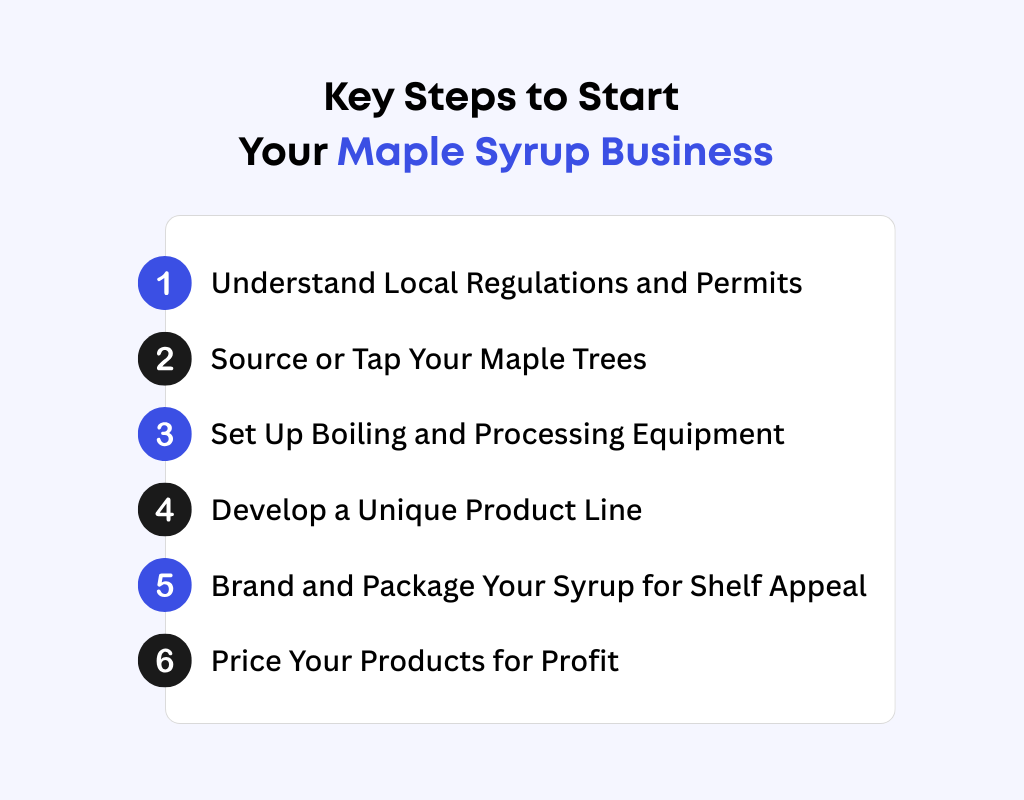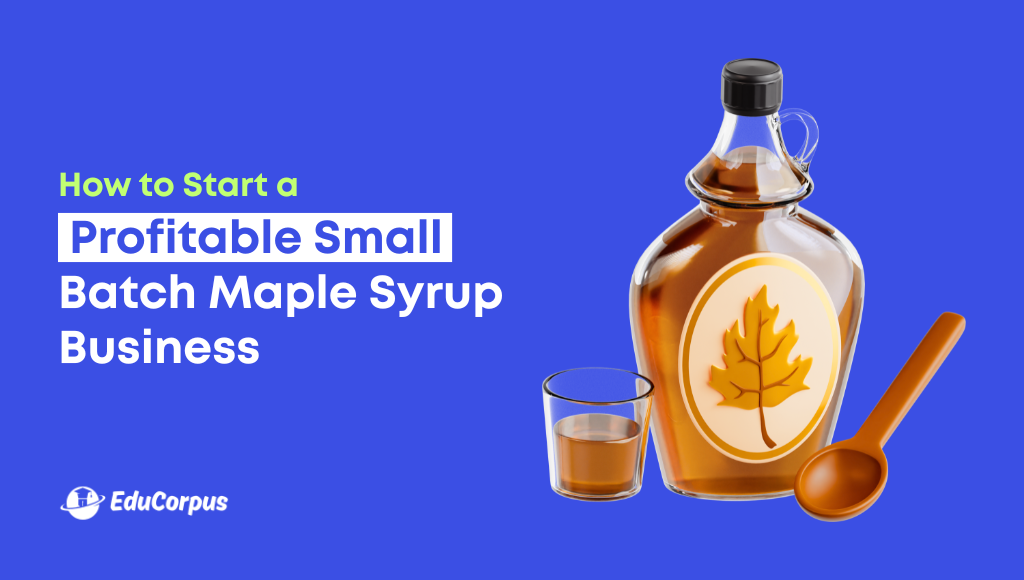Starting a small batch maple syrup business can be both profitable and rewarding. It doesn’t require a factory, a large team, or big money. What you need is clean sap, simple tools, and a clear process.
Today, more people look for local, natural, and handcrafted products. Small batch maple syrup talk fits that demand. When done right, even a few trees can turn into a serious income stream.
This guide will show you how to start small, work smart, and build a syrup brand that sells. You’ll learn the steps, tools, legal tips, and where to sell your syrup. Whether you want weekend sales at a farmer’s market or plan to grow an online brand, this article will help you get there.
What Is a Small Batch Maple Syrup Business?
A small batch maple syrup business is a local, low-volume operation that produces high quality syrup from maple tree sap. Instead of mass production, it focuses on craftsmanship, purity, and flavor. Most small batch producers tap a limited number of trees and process the syrup in small quantities. This allows better control over taste, texture, and quality.
Small batch maple syrup is different from factory made syrup. Large brands use bulk processing to create uniform products at scale. They often blend syrups, use additives, or ship across long distances. In contrast, small batch producers use fresh sap, boil it locally, and bottle it without chemicals or preservatives.
Customers value small batch syrup for its freshness and traceability. They want to know where their food comes from. Local syrups tell a story—of family, land, and tradition. This growing demand has made handcrafted maple syrup a premium product in markets, online shops, and gourmet stores. It’s not just food; it’s a product people trust and enjoy.
Why Small Batch Maple Syrup is a Profitable Niche
People today want clean, local, and natural products. That’s why small batch maple syrup is gaining popularity. Shoppers look for food that feels real—not processed or mass produced. They want taste, quality, and a story behind what they buy.
Starting a small batch syrup business does not require a big budget. You don’t need a factory or expensive machines. With just a few trees, some basic tools, and a simple setup, you can begin production. This low startup cost makes it easy for new producers to enter the market.
What makes it more attractive is the high value people place on handcrafted syrup. Customers are willing to pay more for small batch products. They trust the quality and enjoy supporting local makers. That leads to higher profit margins, even if you’re selling fewer bottles. This mix of low costs and strong demand makes small batch maple syrup a smart and sustainable niche business.
Key Steps to Start Your Maple Syrup Business

Starting a small batch maple syrup business takes planning, tools, and clear steps. Below are the key actions you need to take from setup to selling.
1. Understand Local Regulations and Permits
Before you start boiling sap, check your local laws. Each state or province has different rules for food safety, labeling, and syrup sales. You may need permits for selling at markets or online.
In many places, cottage food laws let you produce and sell food from your home. These laws make it easier for small producers to get started without needing a commercial kitchen. But you still must follow hygiene and labeling rules carefully.
2. Source or Tap Your Maple Trees
To make maple syrup, you need sap—and that comes from trees. If you don’t own land with sugar maples, you can lease trees or buy sap from nearby producers.
Tapping is simple but must be done right. Drill small holes in late winter, insert spouts, and collect the sap in buckets or tubing. A single tree can give up to 10 gallons of sap during the season.
3. Set Up Boiling and Processing Equipment
Boiling turns watery sap into thick syrup. For that, you’ll need a basic evaporator, filters, and clean bottles. Start small with a hobby evaporator or upgrade to a mid size rig as you grow.
Choose your heat source wisely. Wood fired setups are traditional and cheap. Gas or electric may be easier to manage for beginners.
4. Develop a Unique Product Line
Don’t just sell plain syrup—create a product that stands out. Try small batch flavors like vanilla, cinnamon, or bourbon aged maple. These are popular at farmers’ markets and online stores.
You can also expand into maple butter, maple sugar, or even maple candies. These add variety and increase your average order value.
5. Brand and Package Your Syrup for Shelf Appeal
How your syrup looks matters. Use strong branding—a clean label, a memorable name (you can even test ideas with tools like Namelix), and a short brand story on each bottle.
Consider rustic or eco-friendly packaging like glass bottles, kraft labels, or wooden caps. A beautiful bottle makes people more likely to buy, especially as a gift.
6. Price Your Products for Profit
Set prices that reflect your quality and cover your costs. Premium syrup deserves premium pricing, especially if it’s flavored or organic.
Know your cost per bottle—include sap, fuel, packaging, and time. Add a healthy margin to stay profitable while still offering value to your customers.
Where to Sell Small Batch Maple Syrup
Selling maple syrup is more than just making it—it’s about finding the right customers. Where you sell shapes your brand, reach, and profit. Here are three proven sales channels for small batch producers.
1. Local Sales Channels
Local markets are a great starting point. Farmers’ markets, craft fairs, and local grocery stores offer direct access to customers who value natural and local products. These buyers often pay more for syrup they can trust.
Selling in person also helps build a loyal community. Customers meet the maker, hear your story, and come back year after year. That trust creates repeat sales and word of mouth referrals.
2. Online Sales Strategies
Online selling lets you reach beyond your town. You can use platforms like Shopify, Etsy, or your own website to list your products. With quality photos and clear product descriptions, even small syrup brands can attract national buyers.
Use SEO to rank for search terms like “organic maple syrup” or “small batch maple gift.” Combine this with social media marketing—Instagram, Pinterest, and Facebook are great for showcasing packaging, recipes, and customer reviews.
3. Wholesale and B2B Opportunities
Restaurants, boutique cafes, and hotels often want local or unique maple syrup for their menus or gift baskets. You can pitch directly or work through wholesale platforms to reach them.
Some producers also explore white label deals, where you make the syrup and another brand sells it under their name. This helps boost your volume without handling the marketing yourself.
Common Mistakes to Avoid
Many new producers rush into syrup making without a clear plan. One common mistake is overproducing in the first season. Making more syrup than you can sell ties up money and storage space. Start small and grow based on demand.
Another issue is ignoring hygiene rules. Dirty equipment or poor bottling practices can ruin your product and damage trust. Always follow local food safety laws.
Lastly, marketing and packaging often get overlooked. Even great syrup won’t sell without a good label and a story. Invest time in your branding. A clean design and clear message help your syrup stand out. Avoiding these mistakes will save time, protect quality, and improve your chances of long term success.
Tools and Resources for Maple Syrup Entrepreneurs
Starting strong requires the right tools. Beginner kits often include buckets, spiles, filters, and small evaporators—ideal for first timers. As you grow, you can scale to more advanced setups.
Sap collection calculators help estimate how much syrup you’ll yield based on the number of trees tapped. This helps with planning, packaging, and pricing.
Also, look into local maple syrup associations or co ops. These groups offer guidance, share updates on laws and techniques, and connect you with other small producers. Learning from their experience saves time and helps you avoid beginner mistakes.
Real World Examples of Small Maple Syrup Brands
Many small producers succeed by focusing on quality and brand identity. For example, a Vermont based brand gained traction by offering bourbon barrel aged syrup in glass bottles with handwritten labels. Their story connected with customers seeking authentic products.
Another brand partnered with a local coffee shop to create custom label maple shots. It became a top seller during winter months. Their focus on local partnerships helped build a strong regional presence.
The key was not scale—but positioning. Strong packaging, a personal story, and consistent quality made the difference.
FAQs
Is small batch maple syrup profitable?
Yes. With low startup costs and high retail prices, margins can be strong—especially for flavored or premium lines.
How much syrup can you make from one tree?
On average, one tree yields 10–20 gallons of sap per season, which produces about 1/4 to 1/2 gallon of syrup.
Can you make maple syrup at home legally?
Yes, in most areas. But selling it requires following food safety laws and proper labeling. Check local cottage food laws before you start.
Conclusion
You don’t need hundreds of trees or expensive gear to build a syrup business. Start with a few taps, stay clean, and brand your product well. Focus on quality over volume, and let your story connect with buyers.
This guide covered everything from legal steps to packaging and sales channels. Use it to avoid costly mistakes and build a brand that lasts.
Start small, stay authentic, and scale with care. Your profitable maple syrup business can begin with just one tap.


